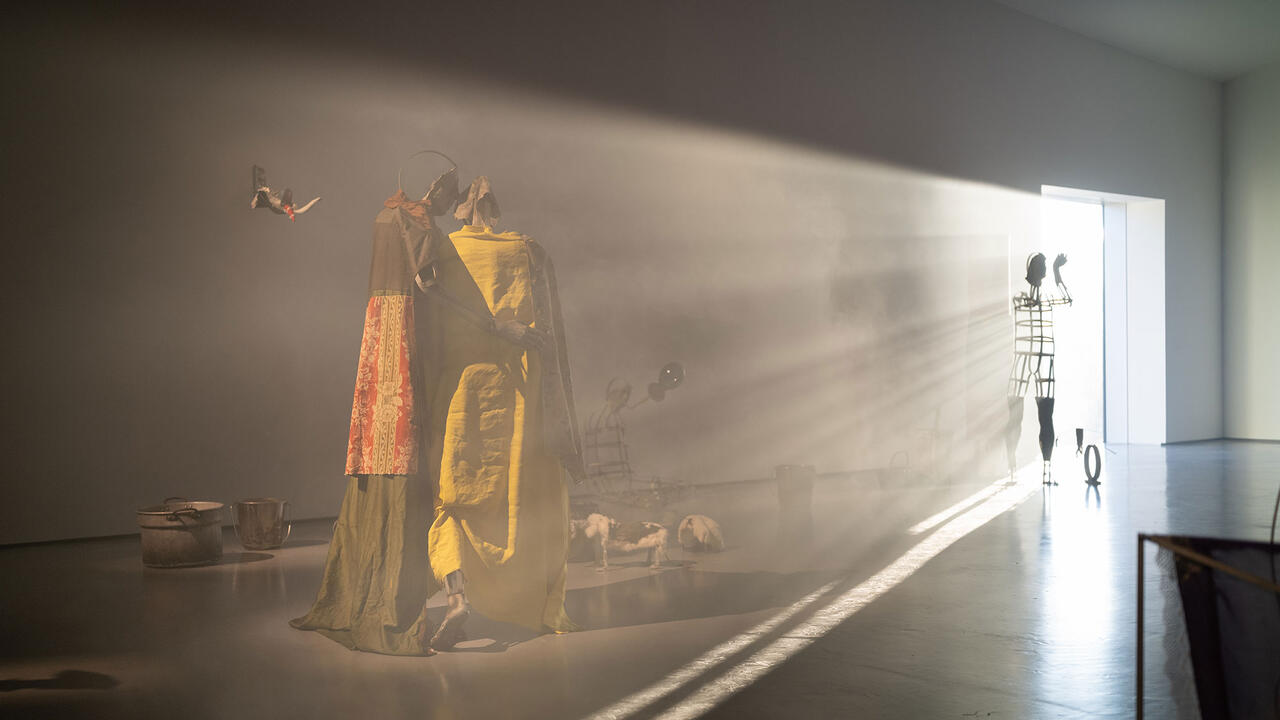Scaling Up
Endings and beginnings in Berlin
Endings and beginnings in Berlin
Few people know that frieze d/e was born in a car park. Our first office was in an old train depot-turned-warehouse-turned-artists’ studios that sat awkwardly in the middle of the parking lot of the Hamburger Bahnhof. The structure was the butt end of the massive, narrow sarcophagus that became home to the Flick collection in 2004. Our portion of the building housed two warehouse-sized studios occupied by Thomas Demand and Olafur Eliasson, an upstairs studio where Tacita Dean worked, a vast basement that was prone to flooding, a backyard garden with a wild array of plants and weeds and one very popular shared coffee machine.
In 2008, the Berlin-based staff of frieze moved into Eliasson’s former offices. Where he had accommodated up to 40 assistants,we had a team of three; then, when frieze d/e was launched, four, then five, then six. When we arrived, there were few traces of Eliasson’s previous operation; his studio was largely used as storage, filled with crates stamped with destinations in China or the Arab Emirates. But before Eliasson left, the offices had been crammed with desks, and the studio was a hub of constant activity. A few odd reminders remained: a collection of cacti, a geodesic dome in the back garden, a net to catch golf balls, mirrors the size of small buildings and a vast assortment of lamps. My desk in his old officeoverlooked a disused grassy lot nuzzling the side of the Hamburger Bahnhof. Buried in the undergrowth was what looked like a crumbling brick wall, or the abandoned beginnings of a simple structure. Often, I saw people urinate on it; sometimes people picnicked there. Those in the know looked for a plaque announcing that it was a sculpture by Urs Fischer entitled Baked Master’s Basket (2005).
By 2008 Eliasson’s studio had outgrown the space and he moved his operation to a four-storey former brewery building in the Pfefferberg complex, Mitte. This used to be a biergarten of crumbling ruins but has been renovated and is now mostly occupied. There’s a youth hostel, an Argentinean steakhouse and it is rumoured that Ai Weiwei is moving in as soon as he is permitted to leave China. Eliasson’s operation has expanded exponentially. The ground floor of his studio has a vast room that is currently dedicated solely to models and maquettes, though it’s hard to tell which ones are for projects to be realized, already built, or which are works themselves. There is more space but also, somehow, less. It’s a development that echoes frieze d/e ’s own expansion – as we are quickly outgrowing our new office.
I first visited Eliasson at the Pfefferberg complex in 2008 a few months before he opened his new art school. Initiated as part of Berlin’s Universität der Kunst, it would occupy a dedicated space in his studio building. At the time it didn’t yet have its name: Institut für Raumexperimente (Institute for Spatial Experiments). In line with his experimental ethos, it was meant to be a five-year project for conducting experiments. This winter the school ended its last semester. That it was always scheduled to have an expiration date is typical of most things in Berlin; look back and it seems that the best things here have always been temporary.
Eliasson originally intended for the school, above all, to get students out of academia, to make them see what role they played in the city and in the world. In the five intervening years, led byco-directors Christina Werner and Eric Ellingsen, there has been a vast and impressive roster of visitors and guest lecturers. All the activities are meticulously documented on the school’s website, in high-res photos and videos: ‘marathons’, talks, critiques, film nights, publications, road trips, ‘walks’ and workshops with titles like Mapping Everything (July 2011) and Master Sun Woo & Master Mu A: Zenergy Serotonin Workshop (December 2013). In this time it expanded from being a way of stepping ‘closer to the city’, as Eliasson first formulated it, to a means of ‘seeing Berlin from the outside’, as he described it recently. Students completed extended programmes in Addis Ababa, Ethiopia; São Paolo, Brazil and Guangzhou, China.
When we met in his studio recently to talk about the school’s closing, we mostly talked about Little Sun, the solar-poweredlamp that Eliasson designed to bring affordable light to those living off the electrical grid, which is now a fully-fledged company that occupies part of the studio building. When I asked him if he feels the lamp has been a successful project, he replied, ‘success is not the point. It’s about scale.’ Scaling up is a fitting metaphor for what’s happening in the art world all over Berlin.
Our interview ended as lunch began and nearly 80 assistants began to converge on the long tables beside the kitchen. It quickly became too loud to hear ourselves talk. I asked him if he’d been back to his old studio which was recently torn down. He didn’t realize it was already gone. Over the Christmas holiday, wrecking crews reduced the building to a pile of rubble and all that’s left now is a hole in the ground. He said he didn’t feel too sentimental about it.
Urs Fischer’s crumbling monument is, ironically, the most enduring structure from our old offices. The offices and studios are gone, to make way for a new ‘Kunstquartier’. The artists we shared with are now displaced and dispersed. Does this mark the beginning of a new, more professionalized Berlin, or the beginning of the end? In a statement on Institut für Raumexperimente’s website that is aptly called ‘Nothing is ever the same’, Eliasson writes, ‘It will be a laboratory for experience but probably nobody will see this experiment as being essentially a model until tomorrow.’














